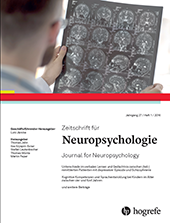Abstract
Zusammenfassung. Gehirnerschütterungen stellen einen bedeutenden Gesundheitsfaktor dar. Ein sehr häufiger Grund von mTBI sind Kollisionen und Stürze mit dem Motorrad (Cassidy et al., 2004). Wenn Helme getragen werden, können bis zu 50 Prozent der mTBI Verletzungen verhindert werden. Die Benutzung eines Helms hat auch eine sehr positive Auswirkung auf den Verlauf von Unfällen mit dem Fahrrad. In dieser zusammenfassenden Arbeit ging es um MTBI hauptsächlich im Sportbereich, weniger im Bereich der Traumen z. B. nach Autounfällen oder als Folge und im Rahmen von Kriegsereignissen, in der noch andere Dynamiken vorherrschen. Viele Details sind noch unklar, es gibt widersprüchliche Befunde über das Ausmaß und die Entwicklung der Defizite.
Abstract. Collisions and motorcycle accidents are a common reason for mTBI (Cassidy et al., 2004). Up to 50 percent of the mTBI can be avoided, when helmets are worn. Using helmets also has very positive effects on the recovery of function following bicycle accidents. This review article focuses on mTBI mainly in sports and to a lesser extent to traumas following car accidents or events of war, cases in which different dynamics have to be expected. Many details remain vague and there are contradictory findings concerning the extent and the and the development of the deficits.
Literatur
(1989).
Mild head injury in sports: Neuropsychological sequelae and recovery of function . In H. S. LevinH. M. EisenbergA. L. BentonEds., Mild Head Injury (pp. 257 – 575). Oxford: Oxford University Press.(2007). Minor traumatic brain injury in sports: A review in order to prevent neurological sequelae. Progress in Brain Research, 161, 263 – 291.
(2013, 23. Mai). Fatale Beschleunigung. Die Zeit, S. 39.
(2004). Incidence, risk factors and prevention of mild traumatic brain injury: Results of the WHO Collaborating Centre Task Force on Mild Traumatic Brain Injury. Journal of Rehabilitation Medicine, 43 (Suppl.), 28 – 60.
(2010). Boxen – akute Komplikationen und Spätfolgen: Von der Gehirnerschütterung bis zur Demenz. Deutsches Ärzteblatt, 107, 835 – 839.
(2013, 11. Juni). Zugriff am 21. 02. 2014 http://www.aerzteblatt.de/nachrichten/54741/Fußball-Hirnschaeden-durch-haeufige-Kopfbaelle
(2002).
Überforderung in Alltagssituationen bei minimalen Funktionsdefiziten . In G. GoldenbergJ. PösslW. ZieglerHrsg., Neuropsychologie im Alltag (S. 131 – 148). Stuttgart: Thieme Verlag.(1989).
Cumulative and persisting effects of concussion on attention and cognition . In H. S. LevinH. M. EisenbergA. L. BentonEds., Mild Head Injury (pp. 153 – 162). Oxford: Oxford University Press.(1999). Neuropsychological impairment in amateur soccer players. Journal of the American Medical Association, 282, 971 – 973.
(2008). Mild Traumatic Brain Injury and Postconcussion Syndrome. Oxford: Oxford University Press.
(2005). Value of neuropsychological testing after head injuries in football. British Journal of Sports Medicine, 39 (Suppl.), i58 – i63.
(2011, 23. November). Vollstrecker im Abendprogramm. Die Rückkehr des lange verletzten Eishockeyprofis Sidney Crosby ist auch für die NHL ein positives Signal. Frankfurter Rundschau, Seite 12.
(2010, 28. Juni). Former Bengal Henry found to have had brain damage. The New York Times, page A10.
(2005). Heading in football. Part 3: Effect of ball properties on head response. British Journal of Sports Medicine, 39(Suppl.), i33 – i39.
(2005). Effects of heading exposure and previous concussions on neuropsychological performance among Norwegian elite footballers. Br J Sports Med, 39 (Suppl I), i70 – i77.
(2012). Fallbericht: Dementia Pugilistica (D. P.) bzw. chronisch traumatische Encephalopathie. Zeitschrift für Neuropsychologie, 23, 133 – 144.



